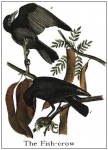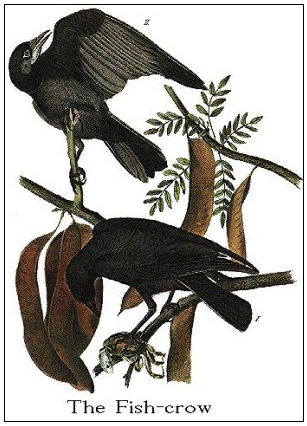Fish Crow, Corvus ossifragus, is a common resident in SE Florida, but it hasn’t always been that way according to Cornell’s Birds of North America online:
Florida. Bailey (1925) stated that Fish Crow in Florida was found mostly in vicinity of brackish and salt waters, although flocks sometimes moved inland in search of food. Howell (1932) called it an abundant resident nearly throughout state, becoming less numerous south of Coconut Grove, Dade Co., and occasional on the keys. Stevenson and Anderson (1994) described it as occurring throughout, except casual on southwestern peninsula and keys, a pattern confirmed by the recent Florida Breeding Bird Atlas (unpubl.), which showed few at inland sites south of Lake Okeechobee or on the keys. Stevenson and Anderson suggest it may have been more common on keys in past because its presence there was mentioned by Audubon (1834), but it may now be increasing there (Robertson and Woolfenden 1992), with peak number of 16 wintering at Key West in 1998–1999 (Pranty 1999). Fish Crow’s tolerance for living in towns resulted in its colonization of urban se. Florida coast since about 1960 (Robertson and Woolfenden 1992).
Our experience here in Palm Beach County appears to bear this out: Fish Crow is common near the coast, where American Crow is rare; the situation reverses itself in the interior. Lake O has both species, but further south, Fish Crow is uncommon.
John James Audubon himself attests to the Fish Crow’s presence in Florida:
The best way to distinguish Fish Crow from American Crow is by call; while AMCR tends to cry in one-note caws, FICR is a bit more negative, saying “uh-oh” or “uh-uh” instead. Audubon describes it this way:
The common note of the Fish-Crow is different from that of the other species of the genus, resembling the syllables ha, ha, hae, frequently repeated. At times the sound of their voice seems as if a faint mimicry of that of the Common Crow; at others, one would suppose that they are troubled with a cough or cold. During the breeding season, their notes are much varied, and are not disagreeable.
I’m not sure if I agree with him that they’re any more nasal than their larger cousins, but it does shows how attuned JJA was to the birds around him.



Comments are closed